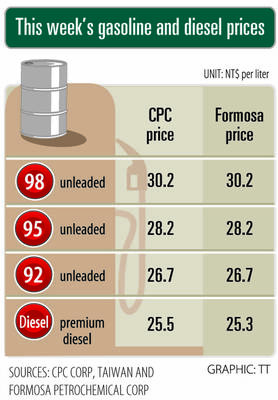With the arrival of winter in Europe and energy prices soaring, tensions are running high over the provision of gas from Russia — especially through the Yamal-Europe pipeline that runs through Poland and Belarus.
Yet the Yamal pipeline is just one part of a complex gas infrastructure network shaped not only by energy needs but also wider economic interests and politics, including strife between Russia and Ukraine.
The pipeline, opened in 1994, runs across 2,000km to Germany from the city of Torjok in central Russia, transiting through Belarus and Poland.

Photo: Reuters
It delivers 30 billion cubic meters of gas to Europe each year, making it one of the most important vehicles for the provision of Russian gas to the continent.
Russia sells Germany gas at a cheaper rate than it does to Poland, in part to make up for the higher transit fees through the longer delivery distance.
However, this means that it is more cost efficient for Poland to buy Russian gas from Germany.
Some of the gas sold by German traders to Poland flows directly into Polish territory, or if that is not sufficient, the pipeline can also operate in reverse to send more to Germany’s eastern neighbor.
Since Dec. 21, last year, the pipeline has been operating in reverse, with gas flowing east back into Poland from the German border, data from management company Gascade Gastransport GmbH seen by Agence France-Presse showed.
This means that over the past few days, Germany has not been receiving gas via Yamal.
Meanwhile, Russian gas continues to flow to Europe through other major pipelines such as Nord Stream I and TurkStream.
It is not unusual for the Yamal pipeline to operate in reverse for short periods, but this latest about-turn comes against a backdrop of political tension over fears that Russia could invade Ukraine.
In Germany, the government has said that in the event of any “escalation,” it would put the brakes on another gas pipeline, Nord Stream 2, which is still awaiting the green light from the authorities.
Some European states, such as Poland and Ukraine, have accused Moscow and Russian energy company PJSC Gazprom of cutting gas supplies to Europe to exert political pressure over these tensions.
Russian President Vladimir Putin has said the change in gas flow through the Yamal pipeline is purely down to fluctuating orders and denied any political motive.
Gazprom, for its part, has called accusations that it is failing to deliver enough gas to Europe “absolutely groundless and unacceptable,” and blamed Germany for dipping into its reserves to supply neighboring Poland.
Berlin on Monday denied any intervention on its part.
“It is not the government that decides on gas flows, but the market, the traders,” the German Ministry for Economic Affairs and Climate Action said.
George Zachmann, a specialist in energy issues for the Brussels-based Bruegel think tank, said that Gazprom might also be “favoring its own pipelines” over those it does not 100 percent control, such as the Yamal pipeline.
A German economy and climate ministry spokeswoman said that “security of supply is still guaranteed.”
Yet Berlin, which has “relatively low” gas reserves with its tanks just 53 percent full, could soon have “difficulties,” Association of Energy Economists president Christophe Bonnery said.
“If contracts are adhered to there will be no problems until at least March,” Zachmann said.
However, “if Russia cannot or will not deliver gas for technical or other reasons, then supplies could fall short,” he said.
The wrangling comes amid an explosion in gas prices, which are up to seven times higher than at the beginning of the year.
The surge is thought to be partly down to a particularly cold winter and an increase in activity linked to the post-COVID-19 economic recovery.
With 40 percent of gas consumed in Europe coming from Russia, Moscow is suspected of taking advantage of the tensions on the world market to reduce supply and drive up prices.
The International Energy Agency in September called on Russia to be a “reliable supplier.”

Merida Industry Co (美利達) has seen signs of recovery in the US and European markets this year, as customers are gradually depleting their inventories, the bicycle maker told shareholders yesterday. Given robust growth in new orders at its Taiwanese factory, coupled with its subsidiaries’ improving performance, Merida said it remains confident about the bicycle market’s prospects and expects steady growth in its core business this year. CAUTION ON CHINA However, the company must handle the Chinese market with great caution, as sales of road bikes there have declined significantly, affecting its revenue and profitability, Merida said in a statement, adding that it would

i Gasoline and diesel prices at fuel stations are this week to rise NT$0.1 per liter, as tensions in the Middle East pushed crude oil prices higher last week, CPC Corp, Taiwan (台灣中油) and Formosa Petrochemical Corp (台塑石化) said yesterday. International crude oil prices last week rose for the third consecutive week due to an escalating conflict between Israel and Iran, as the market is concerned that the situation in the Middle East might affect crude oil supply, CPC and Formosa said in separate statements. Front-month Brent crude oil futures — the international oil benchmark — rose 3.75 percent to settle at US$77.01

RISING: Strong exports, and life insurance companies’ efforts to manage currency risks indicates the NT dollar would eventually pass the 29 level, an expert said The New Taiwan dollar yesterday rallied to its strongest in three years amid inflows to the nation’s stock market and broad-based weakness in the US dollar. Exporter sales of the US currency and a repatriation of funds from local asset managers also played a role, said two traders, who asked not to be identified as they were not authorized to speak publicly. State-owned banks were seen buying the greenback yesterday, but only at a moderate scale, the traders said. The local currency gained 0.77 percent, outperforming almost all of its Asian peers, to close at NT$29.165 per US dollar in Taipei trading yesterday. The

RECORD LOW: Global firms’ increased inventories, tariff disputes not yet impacting Taiwan and new graduates not yet entering the market contributed to the decrease Taiwan’s unemployment rate last month dropped to 3.3 percent, the lowest for the month in 25 years, as strong exports and resilient domestic demand boosted hiring across various sectors, the Directorate-General of Budget, Accounting and Statistics (DGBAS) said yesterday. After seasonal adjustments, the jobless rate eased to 3.34 percent, the best performance in 24 years, suggesting a stable labor market, although a mild increase is expected with the graduation season from this month through August, the statistics agency said. “Potential shocks from tariff disputes between the US and China have yet to affect Taiwan’s job market,” Census Department Deputy Director Tan Wen-ling